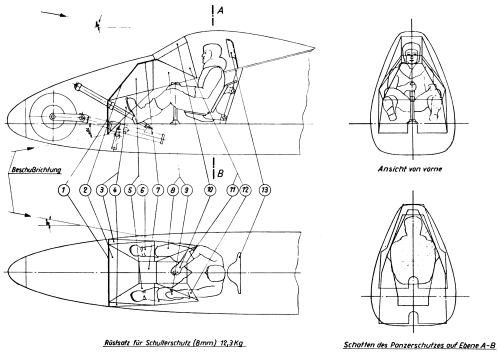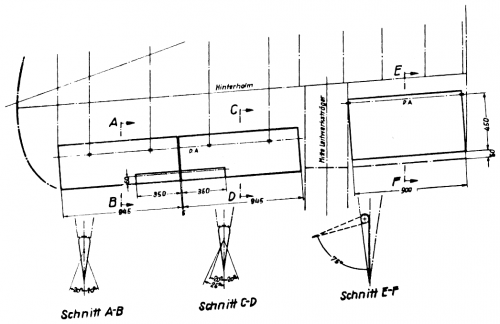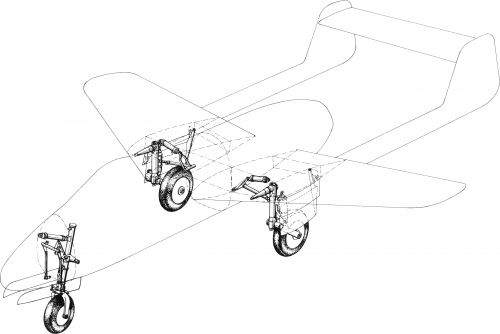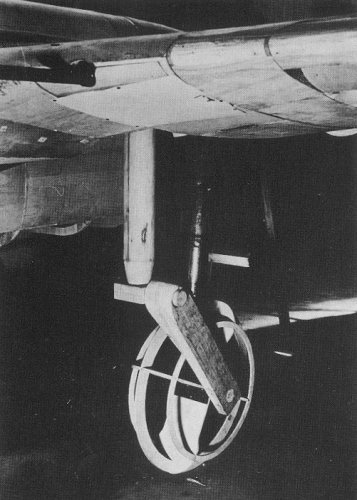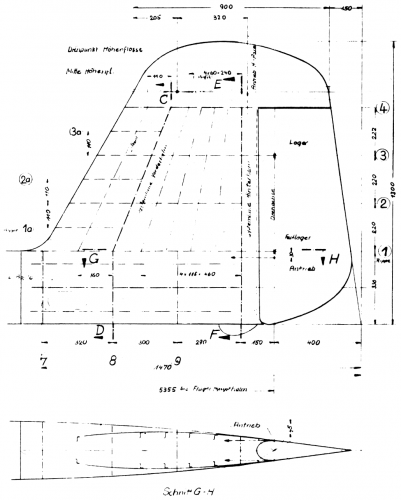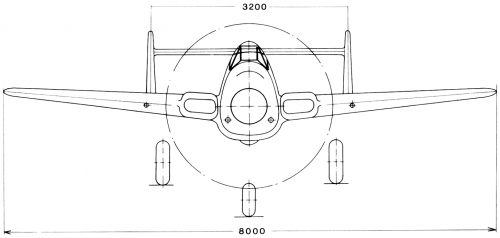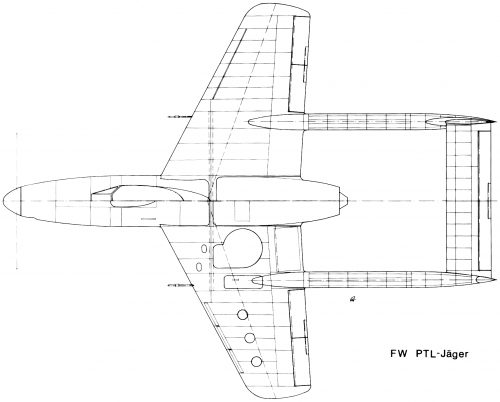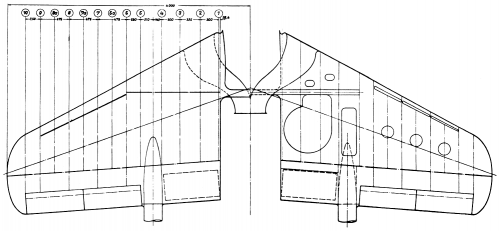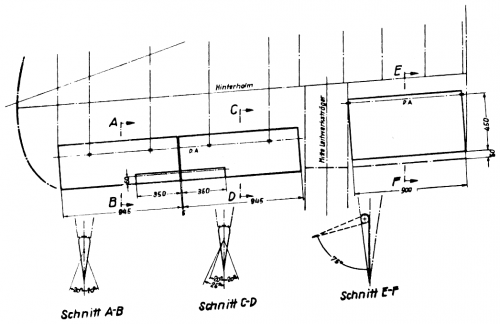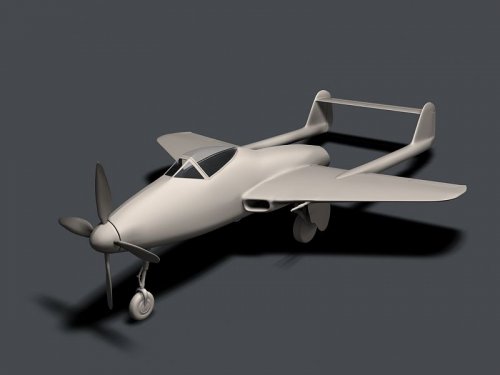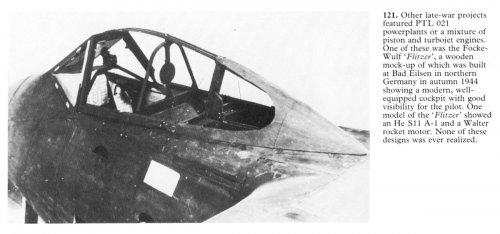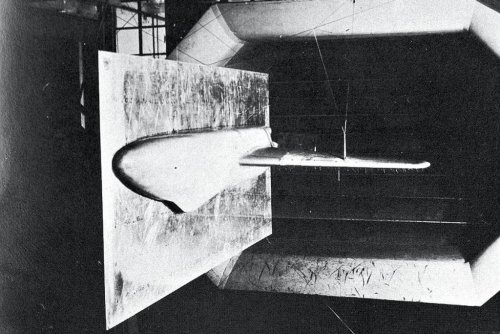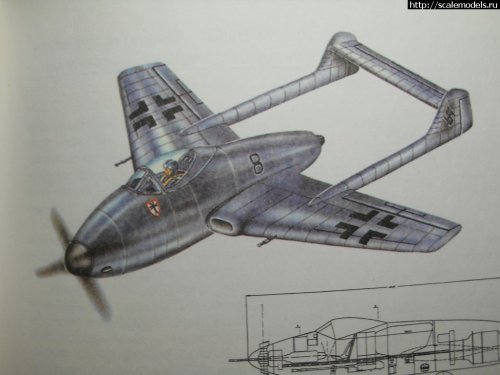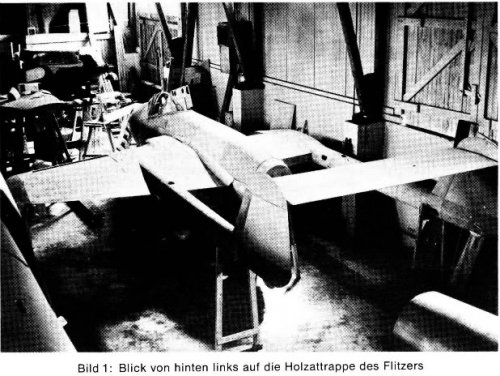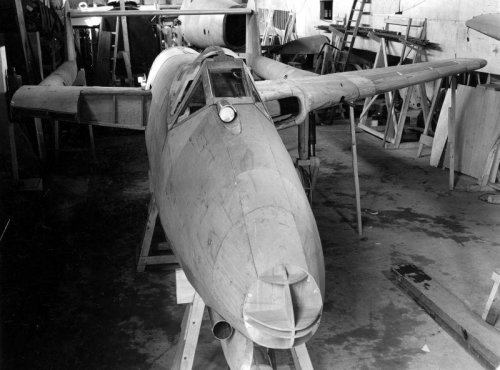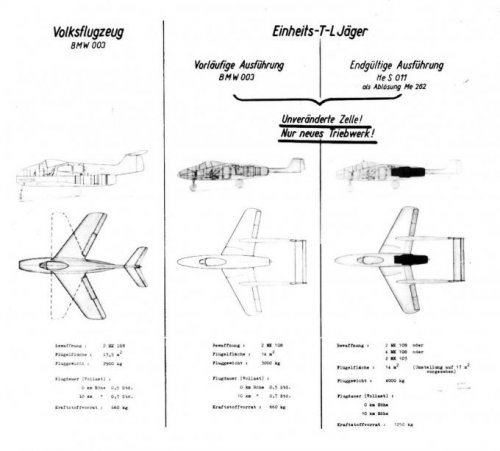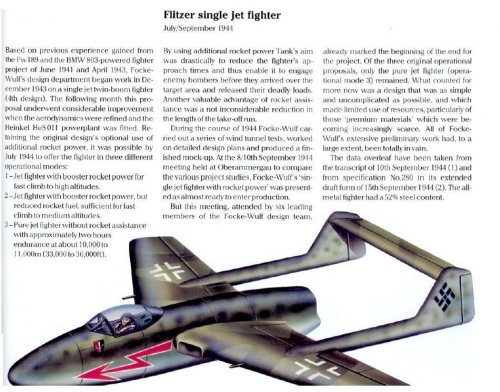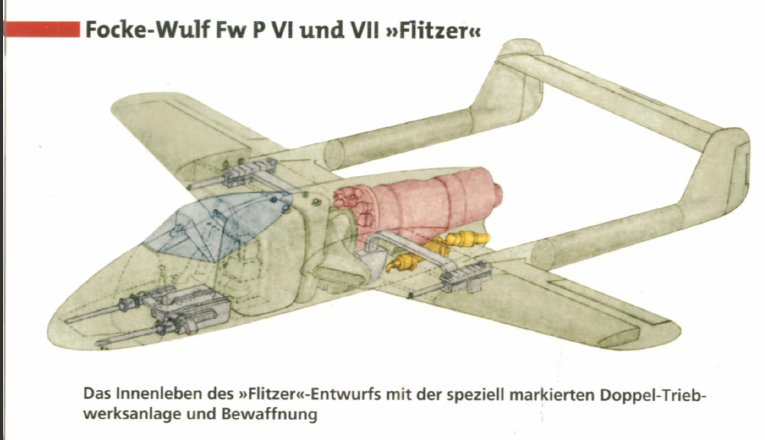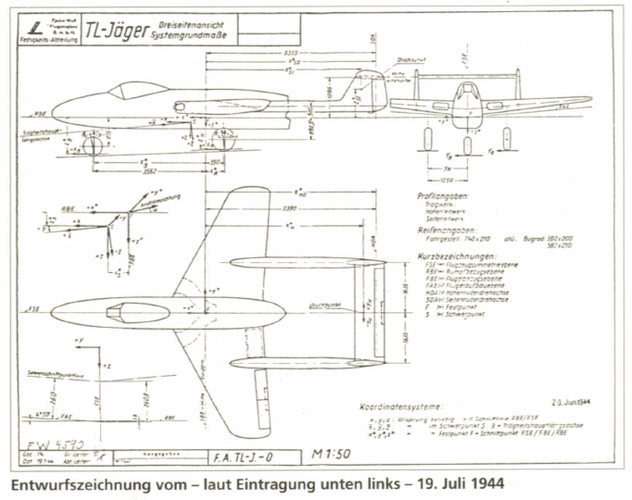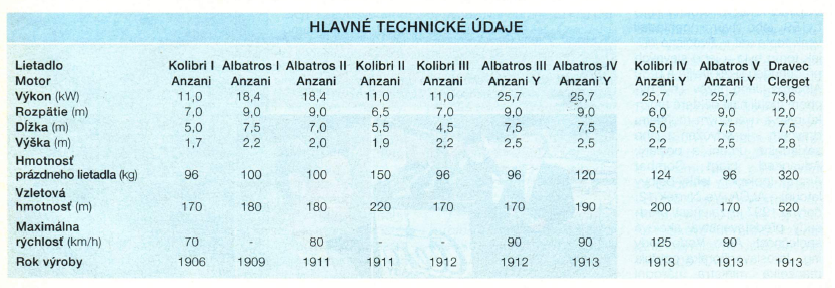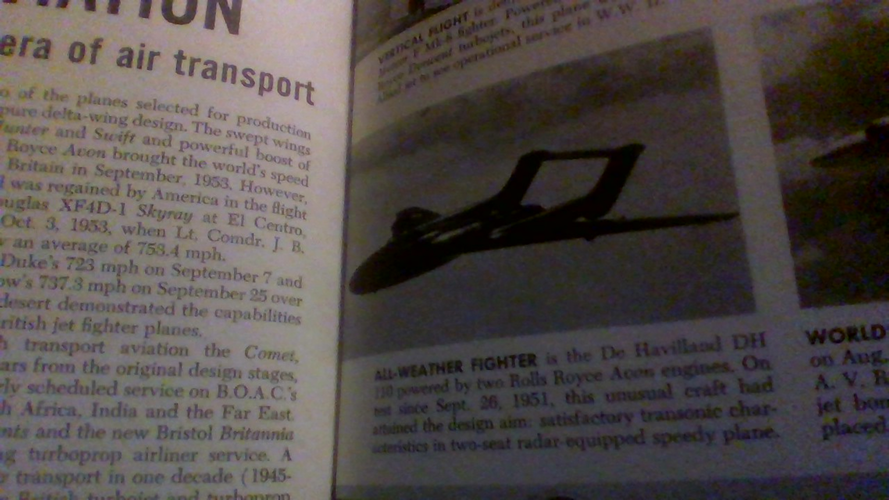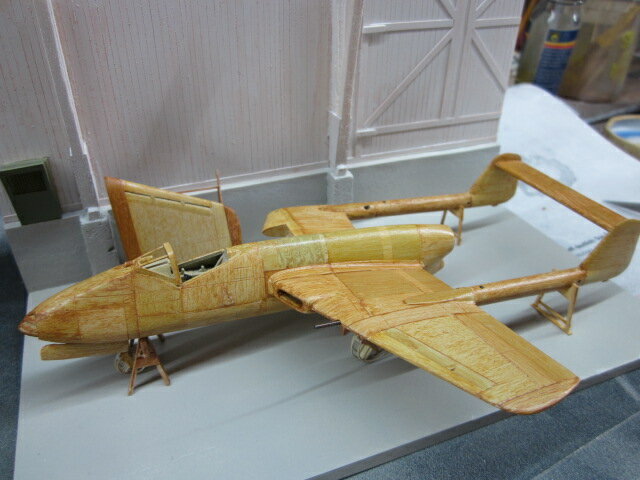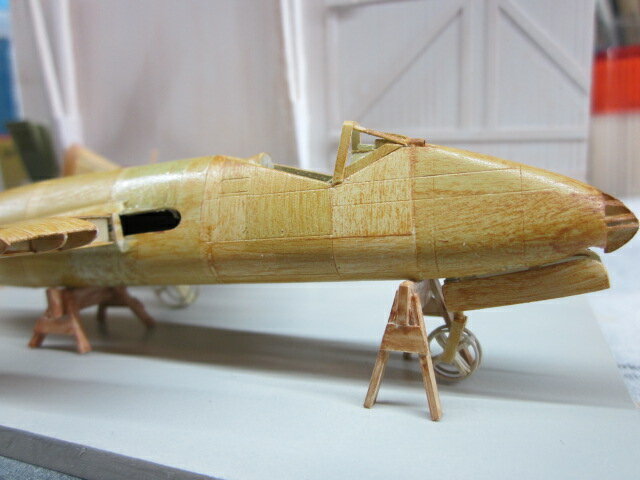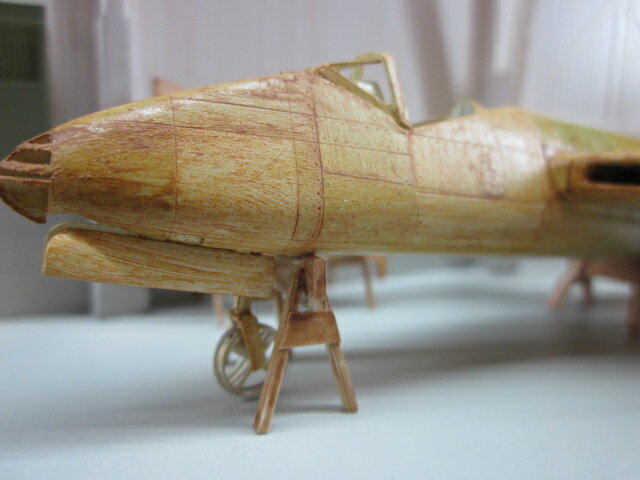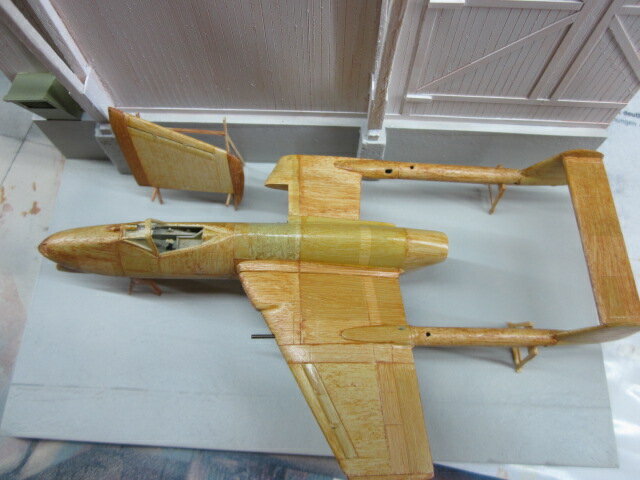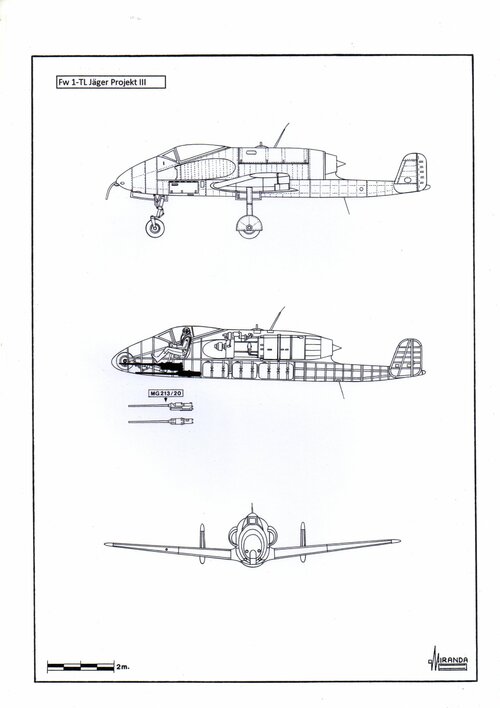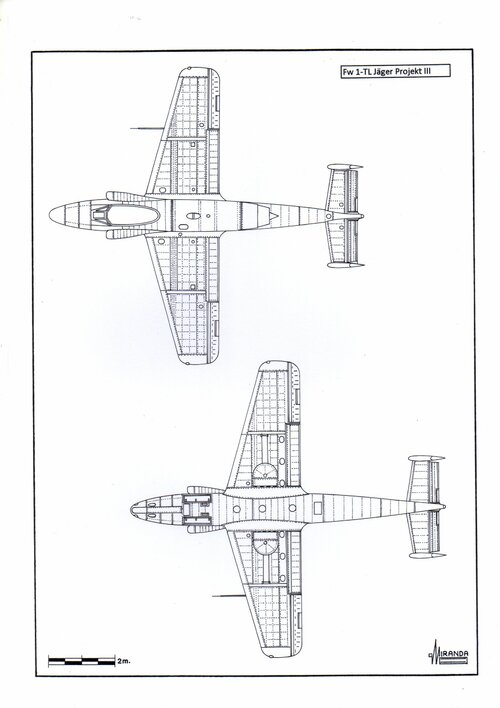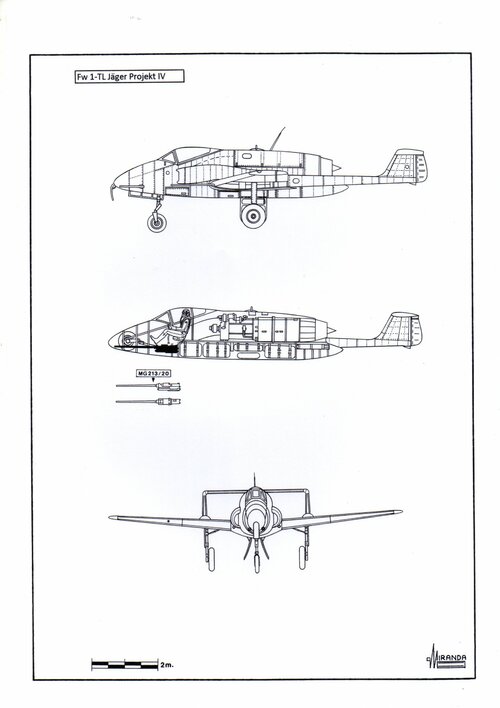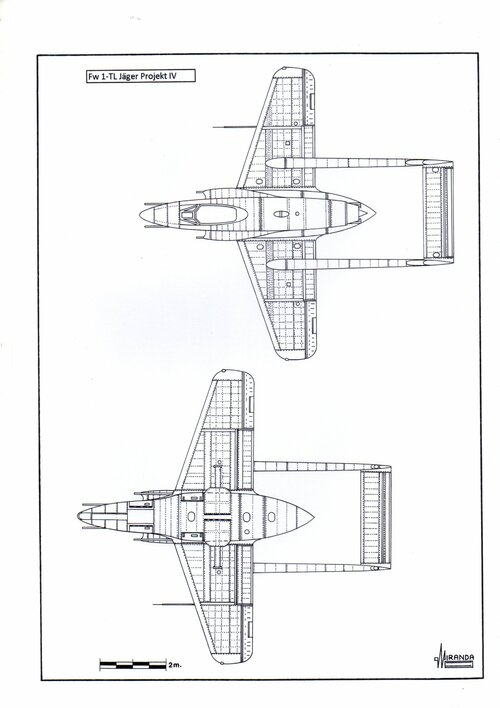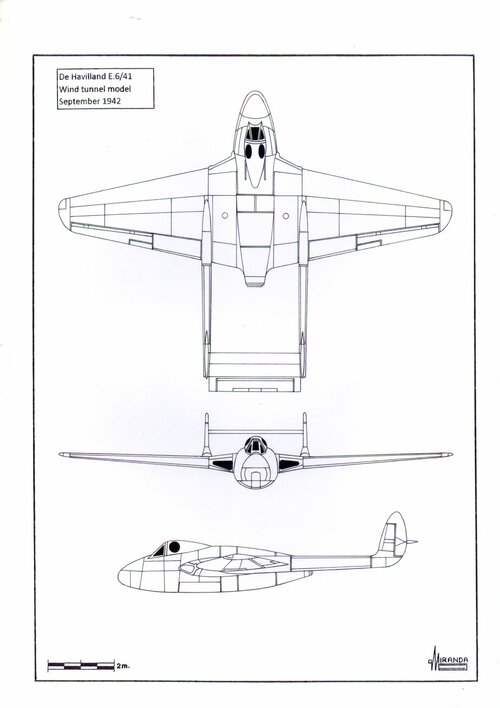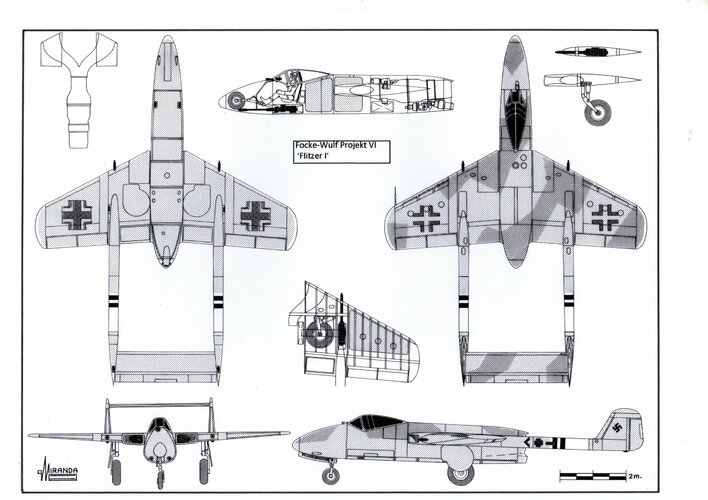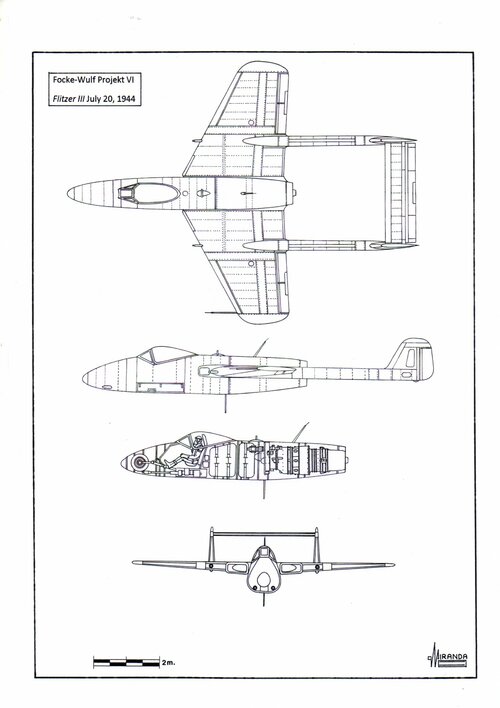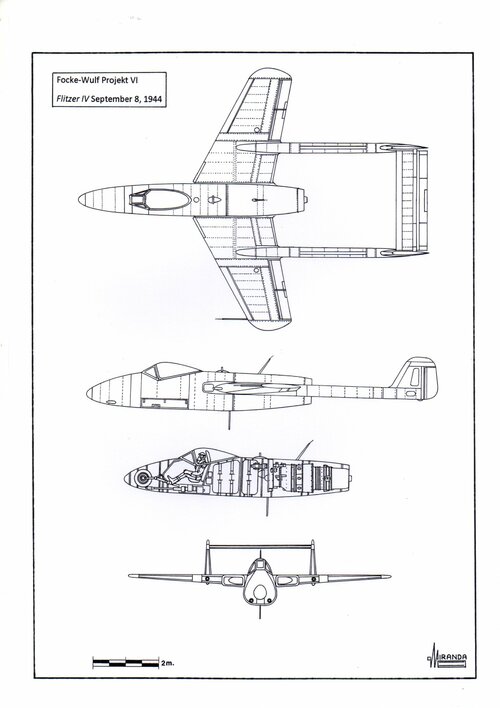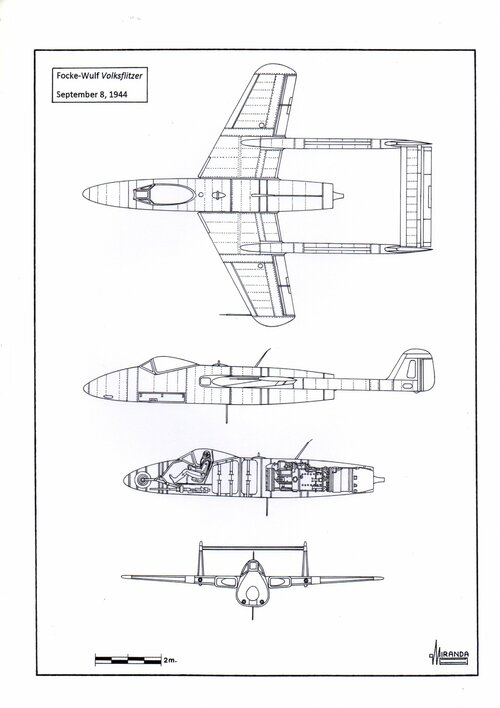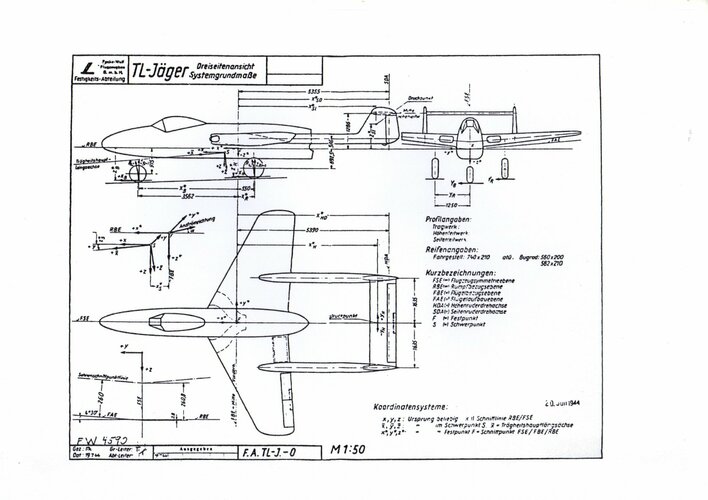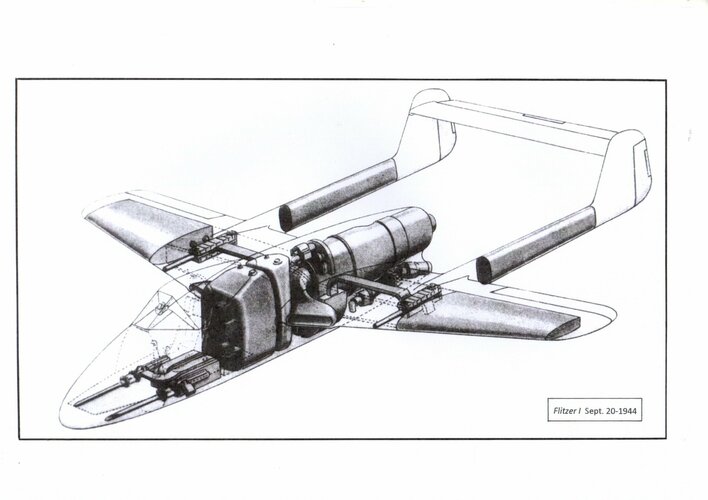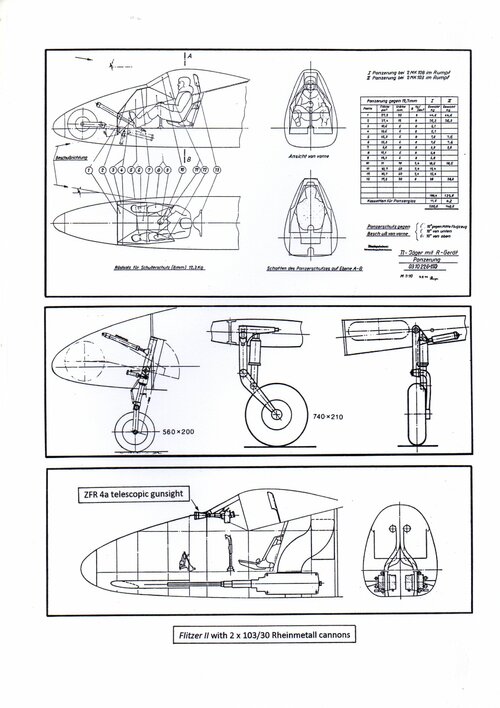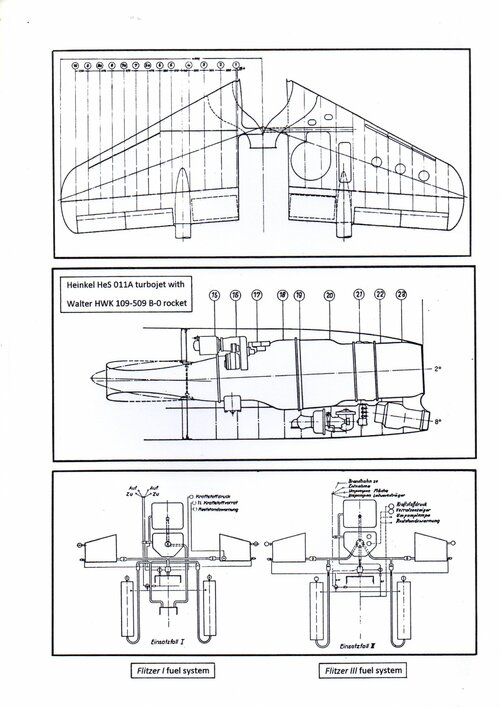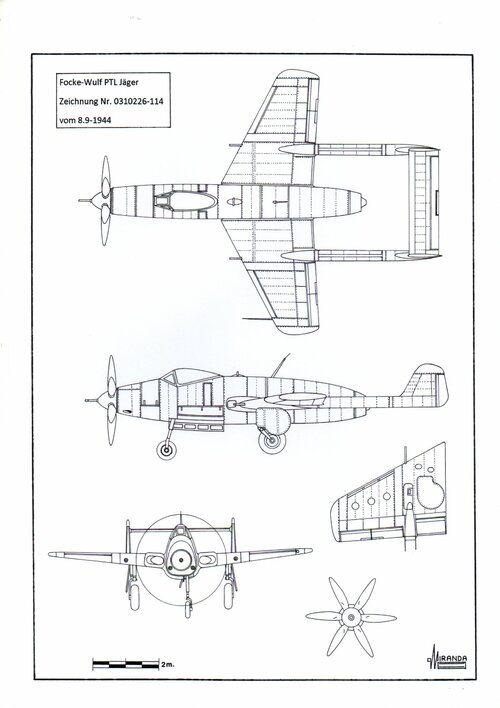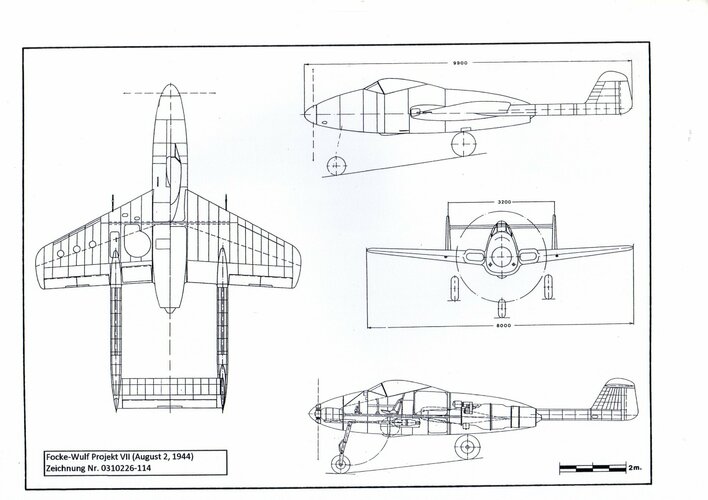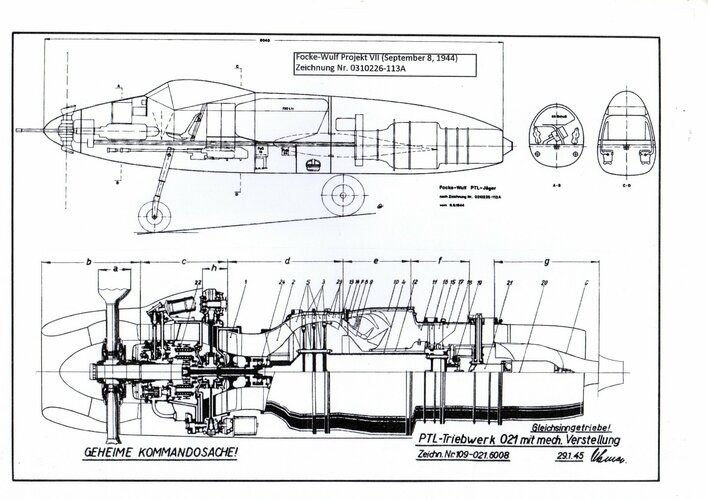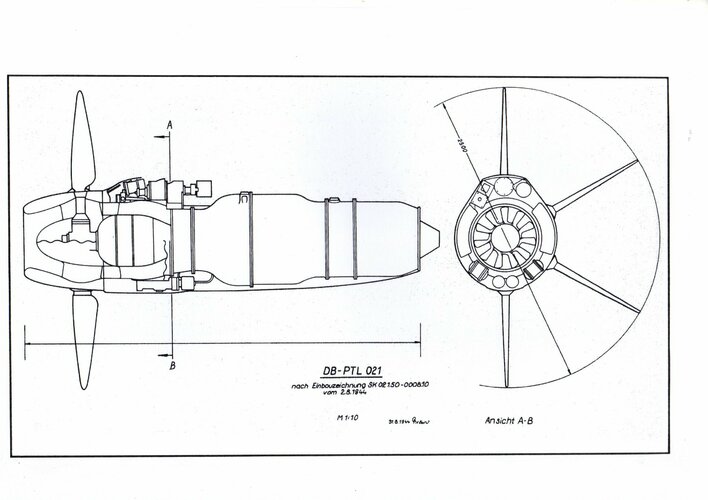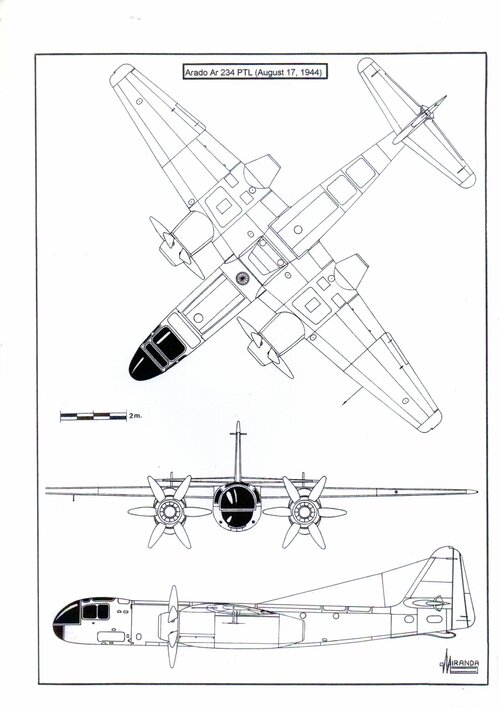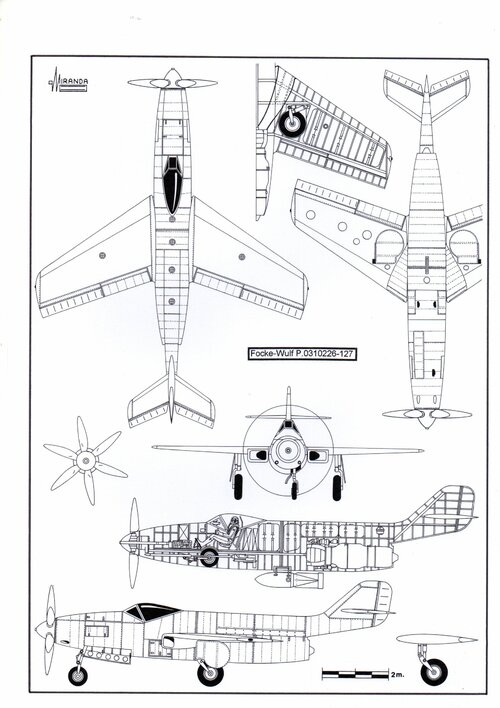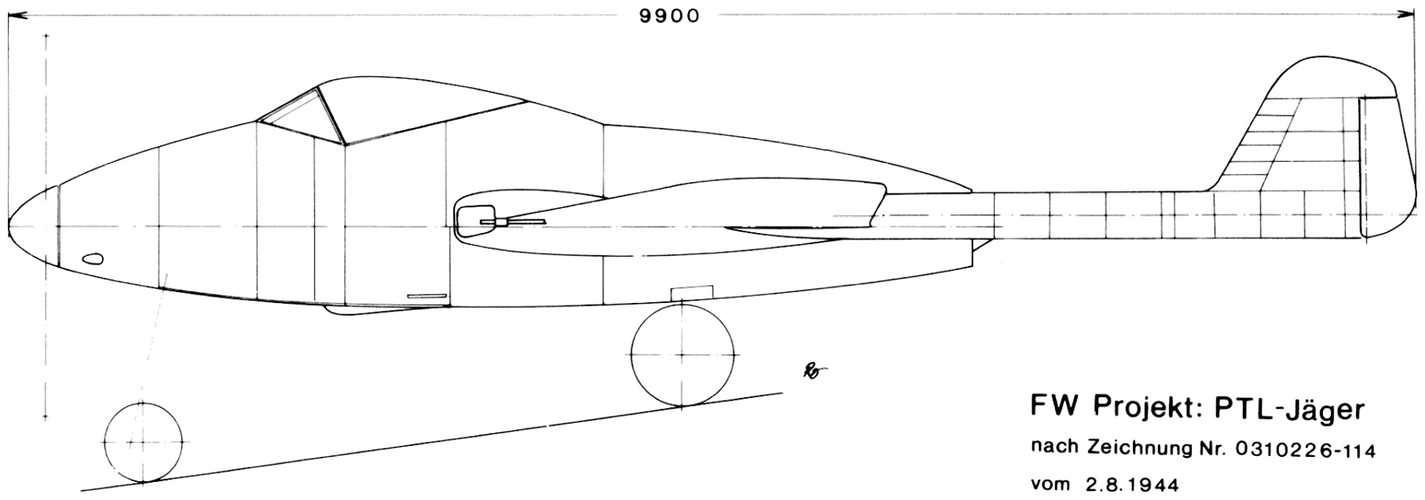Focke-Wulf 1-TLR Jäger Projekt VI
Anticipating that the Technisches Amt would reject
Baubeschreibung Nr.279 (Proposal P.011.001) because of its T-tail configuration, Kurt Tank proposed to the RLM the construction of a more conservative, twin-boom design fighter called
Flitzer (February 1, 1944).
Flitzer was described in the
Baubeschreibung Nr.280 dossier as an air-superiority
Moskitojäger, with turbojet/rocket mixed powerplant, which could be constructed using a 52 per cent of steel, a 45 per cent of light alloy and a 3 per cent of plastics. Its estimated performances were slightly higher than the T-tail design, with an initial rate of climb of 18.2 m/sec, an absolute ceiling of 13,000 m and a maximum speed of 955 kph.
The wing span was only 8 m, the wing area had been reduced to 15.5 sq. m and the height to 2.35 m. The twin-boom formula required to increase the overall length up to 10.55 m to maintain longitudinal stability. The wings, newly designed and with a
3.77: 1 aspect ratio, had 280 cm chord at the root, 29 degrees swept at the leading edge and 4 degrees swept at the trailing edge. They were fitted with fixed leading-edge slots, split-flaps and double ailerons to optimize roll-rate at different speeds. Each wing panel housed one fuel tank with 210 litres of K1 heavy kerosene, one landing gear leg with 240 x 210 wheel, one MK 108/30 cannon with 60 rounds and one air-intake/air-duct ensemble.
The fuselage had a design like that of
Projekt IV. It housed the nose leg, with 560 x 200 wheel, the pressurized cockpit with standard armour, seat ejector and Revi 16C gunsight, two MK 151/20 rapid-fire cannons with 175 rounds each, Two
T-Stoff rocket propellant tanks with 560 and 350 litres, sufficient for 400 seconds of powered flight, one Heinkel HeS 011A turbojet with 1,115 kp static thrust, one Walter 109-509 B-0 bi-propellant rocket with 350 kp peak thrust, One FuG 15Zy RT device and one IFF transponder FuG 25a.
For safety reasons, the rocket propellant
C-Stoff was stored in the tail-booms, in two 160 litres tanks. The estimated range, with 1,071 litres of rocket propellants and 420 litres of K1, was 890 km, with a maximum take-off weight of 4750 kg. The estimated maximum speed was 810 kph, using only the turbojet. The Mauser MG 151/20 were very effective against the Tempest and Thunderbolts, but they lacked the punch needed to destroy a four-engine heavy bomber.
In February 1944, the Fw 190 A-6 of the
Sturmstaffel I, armed with four MG 151/20 rapid-fire cannons, were forced to perform risky head-on pass against the B-17 and B-24 trying to achieve some hits in the cockpit or in the unprotected engines, the only places where the low destructive capacity of the 20 mm ammunition could achieve results. In April, the new Fw 190 A-7/R2 of the 5/JG1 armed with 30 mm cannons Rheinmetall-Borsig MK 108, a weapon capable of destroying a heavy bomber with only five impacts of its powerful ammunition 30 x 90RB of the type
Minengeschoss. But the MK 108 had prematurely entered into service, with a low effective range and high dispersion fire factor that forced the
sturmjägern to shoot from less than 100 m from the target to obtain results.
There was another 30 mm cannon that used a much more powerful 30x184B type munition, with a muzzle velocity that doubled to that of the MK 108 and an effective range of 1,000 m. It was the Rheinmetall-Borsig MK 103, derived from an antitank cannon, which was very difficult to integrate into the single engine fighters because of its powerful recoil and its weight, equivalent to three MK 108.
On 20 June 1944, Kurt Tank proposed to the RLM the construction of a
zerstörer version called
Flitzer II. Basically, it was the same airframe armed with two MK 103/30 in the nose. The main modification consisted in reducing the amount of rocket propellants to only 663 litres, enough for 250 seconds of powered flight, extending the wing area up to 17 sq. m and the wing chord at the root up to 307 cm, with the trailing edge sweep angle being decreased by one degree. The estimated range was reduced to only 570 km but was considered sufficient for the defence of important targets.
Each wing panel contained 210 litres of K1 and a MG 151/20 cannon with 350 rounds. The two MK 103/30s were installed under the cockpit floor, with 80 rounds per gun. The Revi 16C gunsight was replaced by a Zeiss ZFR 4a
Zielfernrohr (telescopic gunsight). The fuselage housed a tank with 560 litres of
T-Stoff and another with 330 litres of K1. The
C-Stoff was reduced to 100 litres stored in the twin-booms.
The new turbojet proposed for this version was a HeS 011 A-0 with 1,300 kp static thrust and the rocket engine a HWK 109-509 B-1 with 400 kp peak thrust. The take-off weight was increased by 100 kg and the absolute ceiling up to 13,800 m due to the increase in power and the modification of the wings. The maximum speed, with turbojet only, was estimated of 830 kph and with both engines of 965 kph.
Flitzer II was proposed to the RLM as a conservative alternative to the Ta 183 A (P.011.018a) although neither project was sufficiently advanced to reach the production phase. In July, a good opportunity was presented with the publication of the
Jägernottprogramm contest and the firm Focke-Wulf presented three projects: Ta 183 A, Ta 183 B and
Flitzer III (20 July 1944).
The latter consisted of a
Flitzer II modified to meet the contest specifications, suppressing the rocket engine, replacing the MK 103/30 with two MK108 /30 and 80 rounds per gun and raising the capacity of the fuel tanks up to 1,000 litres of K1. The low density of the K1 compared to the rocket propellants decreased the overall weight to 3,650 kg. When using only the turbojet, the absolute ceiling fell to 13,000 m and the estimated maximum speed to 830 kph.
In September, the Technisches Amt decided to extend the internal fuel capacity of the
Jägernottprogramm fighter to 1,400 litres and the designers of Bad Eilsen succeeded by installing in the
Flitzer III six K1 tanks: two of 210 litres in the wings, two of 480 and 330 litres in the fuselage and two of 85 litres in the tail booms. The estimated range was 1,100 km, but the excessive drag generated by the tailplane/tailfins ensemble lowered the maximum speed to a value that was unacceptable for the RLM, declaring the Ta 183 A-0 winner of the contest.
The Flitzer project had another chance when the
Volksjäger specification was published on 8 September. Focke-Wulf responded by presenting two projects: the
Volksflugzeug, a simplified version of Ta 183 and the
Volksflitzer (18 September 1944), a light version of
Flitzer I with a maximum weight of 3,150 kg as described in the dossier
Baubeschreibung Nr. 272. The main modification consisted in reducing the wing area to 14 sq. m, reducing the chord at the root to 237 cm and increasing the trailing edge sweep angle to 11 degrees.
The fuselage was modified to allow the installation of a turbojet BMW 109-003 A-2 with only 705 kp static thrust, eliminating one of the fuel tanks. The capacity of heavy kerosene of the type J2, was reduced to 790 litres and the range to 600 km. The lower power of the turbojet, reduced the service ceiling to 10,700 m and the maximum speed to 770 kph, while the
Volksflugzeug could fly at 820 kph with the same engine. Kurt Tank proposed to the OKL the installation of a HeS 011 A-0 that would make the
Volksflitzer an excellent light fighter to complement the Ta 183. The new project, named
Flitzer IV, had 1,120 litres of K1 fuel, 870 km of range and 10,800 m of ceiling.
But even with the higher power of HeS 011, it was estimated that the maximum speed would be the same as that of the
Volksflugzeug powered by the BMW 003 and the
Flitzer programme was definitively cancelled on 3 October 1944.
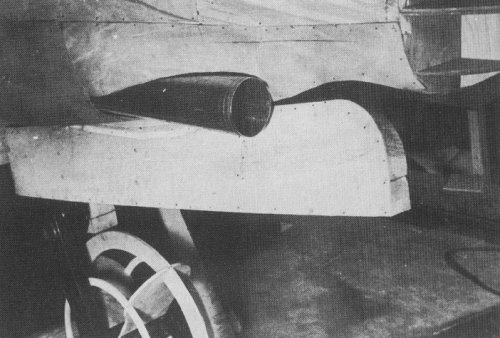 Flitzer_mockup_details01.jpg.pagespeed.ce..jpg128.5 KB · Views: 1,199
Flitzer_mockup_details01.jpg.pagespeed.ce..jpg128.5 KB · Views: 1,199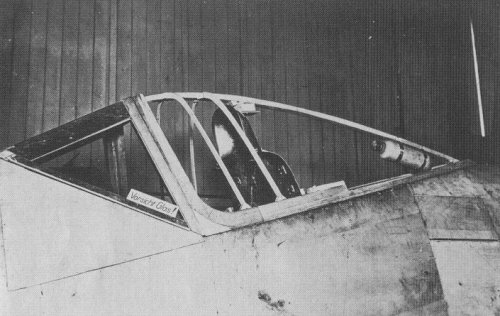 Flitzer_mockup_cp04.jpg.pagespeed.ce.WO-uEJ6fRo.jpg125.6 KB · Views: 1,114
Flitzer_mockup_cp04.jpg.pagespeed.ce.WO-uEJ6fRo.jpg125.6 KB · Views: 1,114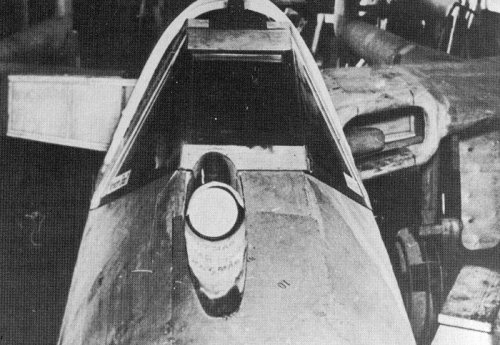 Flitzer_mockup_details02.jpg.pagespeed.ce.wsmeeQWhRl.jpg147.7 KB · Views: 1,050
Flitzer_mockup_details02.jpg.pagespeed.ce.wsmeeQWhRl.jpg147.7 KB · Views: 1,050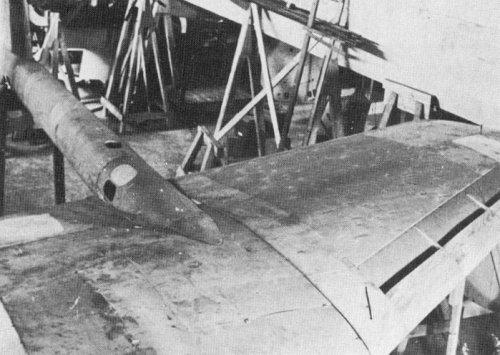 Flitzer_mockup_details04.j.jpg117.9 KB · Views: 1,024
Flitzer_mockup_details04.j.jpg117.9 KB · Views: 1,024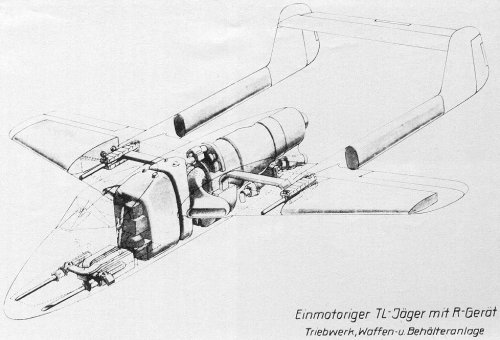 Flitzer_cutaway01.jpg.pagespeed.ce.k0tOFtUkKS.jpg236.2 KB · Views: 1,021
Flitzer_cutaway01.jpg.pagespeed.ce.k0tOFtUkKS.jpg236.2 KB · Views: 1,021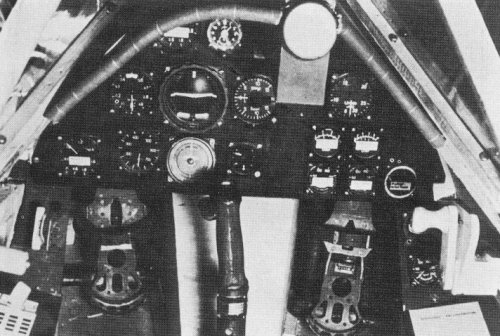 Flitzer_mockup_cp01.jpg.pagespeed..jpg148.9 KB · Views: 293
Flitzer_mockup_cp01.jpg.pagespeed..jpg148.9 KB · Views: 293
